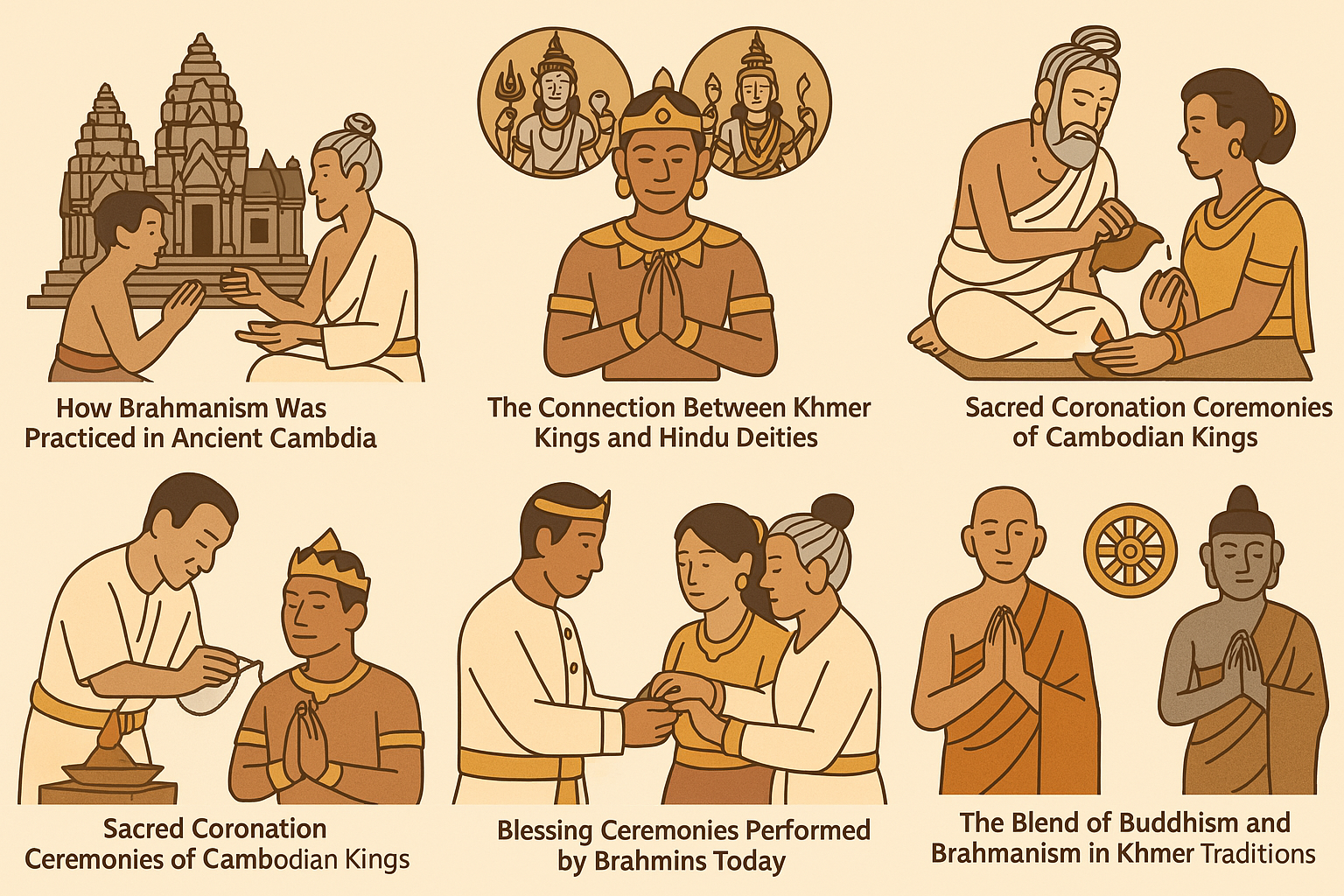Sacred Threads of Hindu Ritual Woven into the Cambodian Monarchy
Though modern Cambodia is predominantly Theravāda Buddhist, the country’s spiritual and royal history cannot be fully understood without acknowledging the influence of Brahmanism—the religious tradition rooted in early Hinduism. Once the spiritual foundation of the ancient Khmer Empire, Brahmanism has left an enduring legacy, particularly in the royal court and state ceremonies that continue today.
Through rituals, royal blessings, temple architecture, sacred texts, and the priesthood itself, Brahmanic influence remains subtly embedded in Cambodia’s cultural DNA. Nowhere is this more visible than in royal ceremonies, where age-old Hindu customs blend harmoniously with Buddhist practice.

How Brahmanism Was Practiced in Ancient Cambodia
During the height of the Khmer Empire (9th–13th centuries), Hinduism was not just a personal religion—it was a state ideology. Kings were often seen as Devarāja (god-kings), believed to be earthly manifestations of Hindu deities like Shiva or Vishnu.
Key Practices:
- Temples were dedicated to gods like Shiva (Baksei Chamkrong) and Vishnu (Angkor Wat).
- Brahmin priests conducted royal consecrations, fire sacrifices (homa), and astrology-based rituals.
- The king’s legitimacy was tied to cosmic harmony, a principle rooted in Brahmanic doctrine.
While Brahmanism never became a religion of the masses, it was essential in the spiritual, political, and cultural life of the royal elite and courtly circles.
The Connection Between Khmer Kings and Hindu Deities
Khmer kings, especially during the Angkorian period, were believed to rule by divine mandate. They were often associated with:
- Shiva, as a destroyer and regenerator of life and power.
- Vishnu, as a cosmic protector and preserver of dharma.
- Indra, the sky god and divine ruler.
By aligning themselves with these deities, kings positioned themselves as mediators between heaven and earth. Temples served not just as religious sanctuaries but as political statements of divine authority.
Even Angkor Wat, now a Buddhist site, was originally constructed as a Hindu temple to Vishnu, reinforcing the king’s celestial status.
The Role of Royal Brahmins in Khmer Court Rituals
Though now fewer in number, royal Brahmins (Preah Eynk) continue to serve in the royal court of Cambodia. These learned priests, often descended from long lines of ritual specialists, preserve Brahmanic rites handed down over centuries.
Their Duties Include:
- Chanting Vedic mantras during royal coronations, cremations, and sacred blessings.
- Performing homa (fire rituals) to invite cosmic forces into ceremonies.
- Setting the astrological dates for state rituals and choosing auspicious times.
- Preparing sacred items like yantra, flowers, and conch shells used in royal rites.
Their presence highlights a unique dual system where Buddhist monks oversee religious morality, while Brahmins uphold the sacred legitimacy of the monarchy.
Sacred Coronation Ceremonies of Cambodian Kings
The coronation of a Cambodian monarch is one of the most profound examples of Brahmanic influence in modern ritual.
Main Elements:
- Conducted by both Buddhist monks and Brahmins, signifying the blend of traditions.
- Involves purification by holy water, symbolizing the king’s rebirth as a sacred ruler.
- Brahmins chant Sanskrit hymns, present royal regalia (sword, crown, slippers), and guide the enthronement rites.
- The king is anointed with sacred oils, and conch shells filled with blessed water are poured over his head.
These rites mirror ancient Hindu coronation customs and affirm the king as a divinely endorsed ruler—even in a modern constitutional monarchy.
Blessing Ceremonies Performed by Brahmins Today
Today, Brahmanic ceremonies continue to mark major events in the royal family’s life—weddings, funerals, inaugurations, and state holidays.
Contemporary Rituals Include:
- Sacred thread-tying for protection and fortune.
- Purification of royal spaces before major ceremonies.
- Offering rituals to celestial spirits and ancestors.
- Water-pouring rites for blessings and abundance.
These ceremonies are often private and symbolic, but they affirm the sacred nature of kingship and its connection to cosmic forces—echoes of the ancient Khmer world order.
The Blend of Buddhism and Brahmanism in Khmer Traditions
Rather than replacing each other, Buddhism and Brahmanism in Cambodia coexisted and interwove, especially in elite and state traditions. Even today:
- Brahmanic mantras are recited during Buddhist festivals.
- Buddhist monks may participate in rituals that have Vedic roots.
- Khmer weddings include both Brahmanic elements (astrology, thread-tying) and Buddhist blessings.
This spiritual fusion forms a uniquely Cambodian syncretism, where ritual continuity links the present monarchy to the divine kings of the Angkorian past, grounding modern national identity in sacred tradition.
Conclusion: Ancient Rituals in a Modern Kingdom
Though most Cambodians today identify as Buddhist, the enduring presence of Brahmanic rituals in royal and state ceremonies reveals the deep layers of Cambodia’s spiritual heritage. These rites serve not only as links to the Angkorian past but also as living symbols of cultural continuity, cosmic legitimacy, and national identity.
In Cambodia, the sacred isn’t confined to temple walls. It lives on through chanting Brahmins, coronation oils, and sacred threads—reminding the kingdom that behind the modern throne still lies the eternal dance of gods and kings.





